Markers indicate locations discussed in this article; click on a marker for more details about a location.
After the Storms: Tradition and Change in Bayou La Batre
Frye Gaillard
Journal of American History, 94 (Dec. 2007), 856–62
About once a century in Bayou La Batre, Alabama [view map], a catastrophic storm comes roaring from the Gulf of Mexico. Ninety-nine years before Hurricane Katrina there was the hurricane of 1906, a mighty wind that lasted for more than twenty-four hours, long before these events had names. The memories of it are present even now in the oral history of the Bayou—in the family stories handed down for generations in this coastal fishing village.
Alma Bryant, a girl of thirteen in 1906, and later her community’s leading educator, remembered being separated from her family in the storm, as the tidal surge tore her house from its moorings. “Rain, the coldest and heaviest I have ever felt, pounded me relentlessly,” she said. “Then the vicious wind picked me up and immersed me in one of those craters made by an uprooted tree. I clutched the limb . . . and held on for dear life, barely conscious of the weird noises all around me—the shrieks of frightened birds, the woeful cry of a drowning calf, the dying moans of Mr. Deakle’s old white mare pinned beneath the demolished barn.”[1]
Bryant, in the end, was one of the lucky ones. She managed to swim and clamor through the floating debris—“the limp, dead chickens, bloated hogs, writhing snakes”—toward the flickering light of a house in the distance. At least 135 others did not make it, and the Mobile Register, the morning newspaper in the nearest city, carefully recorded the details. Two Bayou women lining up the bodies, covering them with shrouds; a frightened family emerging from the woods, where they had drifted all night in an open skiff; a writer’s description of those who survived: “Most . . . resembled great chunks of liver-colored beef, so badly were they battered and bruised.”[2]
This now is a part of the lore of Bayou La Batre, a place where residents freely acknowledge that life on the edge of the continent is hard. The hurricanes come and the hurricanes go, requiring resilience of those who survive. So it was in 1906, and so it is after Hurricane Katrina. But there is another understanding more subtle and elusive, more difficult for many people to explain. When the truly massive storms hit the Bayou, those once-a-century calamities, they have often changed the course of local history, much as they might alter the course of a river.
In the decade after 1906, the thriving tourist industry in Bayou La Batre and the neighboring coastal village of Coden began to shrink into almost nothing, as turn-of-the-century resorts—the Rolston Hotel, the Oleander Hotel—began to close their doors. The Bayou slowly turned in on itself, returning to the source of its identity and survival: extracting a modest living from the sea. The work was hard, but the people found satisfaction in the harvest of shrimp and oysters, fish and crabs, depending on the season. “We love it like a farmer loves digging in the dirt,” said longtime oysterman Avery Bates. “You sweat hard and see the bounty of the sea, and you’re part of a heritage going back for generations. You’re feeding your family and the people around you. You know you’re involved in something worthwhile.”[3]
But as Bates and others are quick to tell you, the seafood industry has changed over time. The technology improved, and the catches grew large. But by the early years of the twenty-first century, high fuel prices, imported shrimp, and the growing complexity of government regulations had made many in the Bayou fear for the future of their profession. They had already lived through major upheavals, chief among them, a massive immigration in the 1970s of Asian refugees—Laotians, Cambodians, and Vietnamese—fleeing war and genocide in their homelands. These new arrivals made a place for themselves in the life and economy of Bayou La Batre, many of them working in the seafood industry, but soon they too faced an uncertain future.
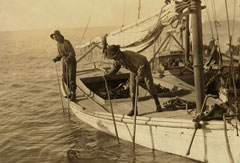
A young oyster fisher works on an oyster boat in Mobile Bay near Bayou La Batre, Alabama. February 1911. Library of Congress Prints and Photographs Division.
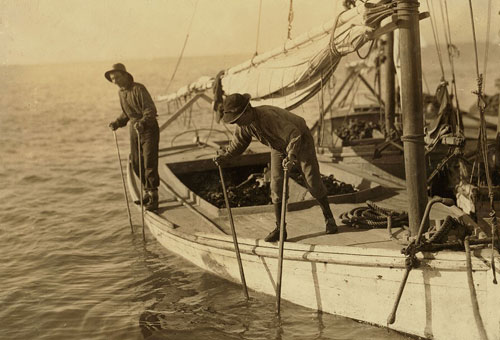
A young oyster fisher works on an oyster boat in Mobile Bay near Bayou La Batre, Alabama. February 1911. Library of Congress Prints and Photographs Division.
Against that backdrop of economic distress, the city fathers began negotiating in 2005 with Tim James, who is one of the most powerful developers in the state and the son of a former Alabama governor. James was proposing, essentially, to transform the town with high-rise condominiums—a symbol of affluence along the waterfront. In a community where the annual median income was less than $25,000 per household, the development plans were a source of alarm, especially for those of lesser means. “They are chomping at the bit to change this place,” said longtime shrimper Randy Schjott. “A lot of ordinary people are going to be pushed aside.”[4]
That was the situation in the summer of 2005—shrimpers paying high fuel prices, seeing profits squeezed by imported shrimp, and fearing their waterfront businesses would soon be displaced by developers. And then came Katrina. On August 29, 2005, the storm surge swelled to nearly twenty feet, and in a community built essentially at sea level, more than 2,000 of 2,300 residents were forced from their homes. It was a devastating blow for Bayou La Batre, prompting a fourth of its population to move away and leaving twenty-three of its shrimp boats stranded on land.[5] But as the community began to rebuild, a familiar ritual in its history, some saw an ironic opportunity. The sobering reality of the Katrina disaster slowed the rush toward high-end development and gave residents a chance to ask questions. What kind of community did they want theirs to be? Was there a path to a strong economic future that still took advantage of the Bayou’s traditions? Could the people of different cultures work together? As this article goes to press, the answers are by no means clear. But to understand the gravity of these issues—the difficulties as well as the hopes that are shaping the community in the wake of this latest natural disaster—it is necessary to go back into time.
The human history of Bayou La Batre began long before the arrival of the white man. For nearly eight thousand years, Native Americans prospered along the twelve-mile length of the bayou, finding plenty of food in the slow-moving waters. They hunted turkey and deer in the forests and fished the shallow waters of Mississippi Sound—that tranquil part of the Gulf of Mexico that runs behind a string of barrier islands.[6]
Arthur McRoy knows the story well. He is one of the Bayou’s official historians, a tanned and weather-beaten man in his sixties, who has lived in the area for most of his life. He often tells the story of his own family’s arrival—how his grandfather, Leslie Garner McRoy, then a captain in the Alabama National Guard, came to the community in 1906 to direct the burial of the Bayou’s dead. Arthur McRoy still has the written accounts of his grandfather’s mission: “Body of a white man about 20 or 22 years old . . . identification not possible. . . . Body of a white man heavy built . . . had on a double breasted rubber coat.” Despite his grisly introduction to the place, the elder McRoy decided to stay. There was something about the spirit of the town, a resiliency and a self-reliance, he said, and a man could make his living from the sea. There were shrimp and crabs and oysters in abundance, and people came to trust in the bounty as they had since pre-Colombian times.[7]
The technology transformed in the twentieth century—oystermen moved from hand tongs to mechanical dredges, then back to tongs when they discovered they were doing damage to the reefs. The shrimpers also worked to perfect their technique. At the beginning of the century, they worked with cast nets, going out alone or in twos in their bare wooden skiffs. The nets most often were braided by hand, then dyed with the bark of a red oak tree, which became a cottage industry in the town. But as the century progressed, the boats evolved—their engines strong enough to pull trawling nets. Arthur McRoy, among others, recalls with nostalgia “the sound of the engine on a misty November morning.” The size of the catches steadily increased, white shrimp harvested during the day, brown shrimp often harvested at night. By the middle of the century the boats had also grown. These steel-bottomed trawlers, many of them sixty-five feet long, were capable of handling the open waters of the Gulf, and the Bayou’s catch soon expanded to other species of shrimp, including pinks and royal reds from off the coast of Florida.[8]
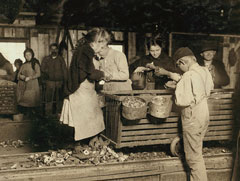
A young girl stands on rough shells while shucking oysters near Bayou La Batre, Alabama. Alabama Canning Company, February 1911. Library of Congress Prints and Photographs Division

A young girl stands on rough shells while shucking oysters near Bayou La Batre, Alabama. Alabama Canning Company, February 1911. Library of Congress Prints and Photographs Division
A ship-building industry sprang up as well, and Bayou La Batre became a prosperous, blue-collar place. In some ways, it was an old southern town, biracial with a white majority holding political and economic power. But it was also a community on the edge of the sea, resembling, perhaps, a fishing village on the shores of New England in its single-minded obsession with the harvest. As an oysterman put it recently, “I’d rather tong oysters and run a crab shop than be president of the United States.” Not everyone felt that way, of course. In every generation, there were always a few who moved away, but there were more who stayed, and the Bayou, as a community, became set in its ways. New generations did what their fathers had done, and the heritage and sense of place ran deep. “I remember,” said Marie Schjott, who has lived most of her eighty-plus years on the Bayou, “we moved to Mobile when I was in the third grade. Didn’t come back until I finished high school. All that time, I grieved. I said they’d have to shoot me to get me out of here again.”[9]
As soon as her forty-mile exile was over, Marie Schjott, still a teenager, returned with her family to their homeplace on the water. Her grandfather Oliver Stillwell Cain farmed a plot of land that ran east from town, growing fruit trees and raising cattle, while operating a seafood shop on the side. Not long ago, his great-grandson Randy Schjott, a shrimper who races cars on the side, wrote a poem about the character of his ancestors, paying sentimental tribute to “a time of wooden boats and iron men.”[10] Such was the sense of tradition on the Bayou, a place of lyrical stories and lore, where the people seemed to know who they were.
But there has been a downside to identifying with the past, that reluctance to change or pursue other skills. By the end of the twentieth century, the statistics told the story of a struggling community. The annual median household income was $24,539, and only 55 percent of the Bayou’s residents had earned as much as a high school diploma. Less than 8 percent had a college degree.[11] To complicate those unimpressive numbers, Bayou La Batre has found itself confronted, over the last few decades, by powerful forces of change, both demographic and economic.
In the 1970s, following the end of the Vietnam War, Asian refugees began to relocate in the area, and within a decade they made up a third of the community’s population. There had been other immigrations in the past—Filipinos in the nineteenth century, especially in areas to the west—but nothing like this in Bayou La Batre. “We thought,” lamented one local shrimper, “they were going to name it Bayou Nam.”[12] Walton Kraver, who grew up in the Bayou and became one of its most successful businessmen, said some older families moved away, believing the town was no longer the same. But the population stabilized by the 1990s, and the overwhelming consensus in Bayou La Batre now is that, despite earlier apprehensions, the refugees and the other residents, with a few exceptions, have coexisted well. “We get along with Asians better than anybody,” said shrimper turned repairman Harley Bates. And Rodney Lyons, a fifth-generation Bayou resident who runs a tavern above his seafood shop, maintains that the Asian refugees breathed new life into the seafood economy.
It made Bayou La Batre even more of a seafood production town. The Asian workers would pick 100 to 120 pounds of crabmeat a day. They doubled the production of American pickers. It made the crab business grow. If they were shucking oysters, they sometimes worked twelve hours a day, and changed the whole complexion of oyster production. They shrimped also. They bought up old boats and worked hard and upgraded their boats. They were heavy producers, and people had to respect that.[13]
After all, said Lyons, these were survivors—resourceful people who had often endured unimaginable hardships before they came to America. One of Lyons’s friends, Heang Chhun, the president of the Cambodian Association of Mobile, escaped the killing fields of the Khmer Rouge, but lost a part of his family on the way. Chhun, who speaks four languages and serves as a translator and recertification specialist for the Federal Emergency Management Agency (fema), is more willing than most to tell his own story, despite the painful memories it involves. “I came to this area in 1976,” he says, “without no English. In that time, people were looking for way to escape Cambodia. When communists take over, I escape to Thailand; took 19 days, with only two or three days food and water. Somehow I survive.” In the insanity of those times, it was Chhun’s brother, a victorious fighter for the Khmer Rouge, who told him to get out of the country: “He said, if you stay, maybe I am the one who kills you.” But in the desperate and confusing flight to Thailand, Chhun lost his wife, a daughter, and a son, and learned that his father had been killed by the Communists. “I lost my country, I lost my family,” he says. But he did not want to lose all sense of who he was. Near the village of Irvington, Alabama, just a few miles north of Bayou La Batre, he helped establish a Cambodian community, centered on a Bhuddist temple on a dirt road far from the major highway. There are thirty families there: some live in mobile homes, others, like Chhun, in sturdy brick houses, grateful for the relative tranquility they have found. For many of them, the work is still hard, long hours spent shucking oysters and cleaning crabs, but the Cambodians, he says, tend to be quiet, uncomplaining people. “Nothing is perfect,” Chhun concludes. “We consider it okay.”[14]
New Orleans is home to one of the largest settlement of Vietnamese American in the Nation. Follow thread in Leong, et al., “Vietnamese American Community in New Orleans East” >
Robert Shipp, a marine biologist at the University of South Alabama, who has observed the evolution of Bayou La Batre, believes that the community has responded well to the Asian refugees. It has made a transition now familiar in the South—from a segregated society with a white majority to a multicultural community (52 percent white, 33 percent Asian, and 10 percent African American).[15] At the beginning of that transition there were occasional conflicts between white shrimpers and some of their Vietnamese counterparts. “If you were trawling west to east, they would want to go north to south,” said a white boat owner. But they shared the culture of the sea, and within a few years, understanding prevailed.[16]
In Shipp’s estimation, the changing reality of the seafood industry has been far more challenging for the community; the industry is an $80 million enterprise in the Bayou, which represents 85 percent of its economy. High fuel prices and imported shrimp have squeezed profit margins for the shrimpers. “It’s been just devastating,” said Shipp. “The future of the shrimp industry is not good at all.” Crabs and oysters have been more stable, but in Bayou La Batre, shrimp production has been the biggest industry, and an ongoing conflict between the shrimping fleet and commercial sports fishermen in pursuit of red snapper has complicated matters. Snappers are often caught in the shrimp nets, which has prompted an intricate set of environmental regulations. The oystermen, too, have been embroiled in environmental debates. Mechanical dredging has recently been legalized again, and many oystermen fear that despite the efficiency of the dredging process, it will do major damage to the oyster beds.[17]
Such was the atmosphere of economic insecurity when the developer Tim James announced his plan in 2005 to build condominiums along the Bayou waterfront. The heart of his $200 million proposal was the purchase of Lightning Point, a spit of land owned by the city where the bayou empties into Mississippi Sound. There he planned to build high-rise condominiums with a commanding view of the Gulf. Some in Bayou La Batre were excited, seeing possibilities for economic progress. Others, particularly the small businesspeople, feared being swept aside. On other parts of the Alabama coast, they had seen a combination of gentrification and sprawling high rises change the fundamental character of the area. They feared the same for Bayou La Batre.[18]
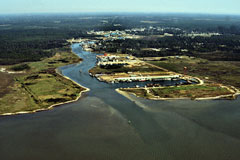
An aerial view of the Bayou La Batre harbor entrance from the Gulf of Mexico to the Northwest. U.S. Army Corps of Engineers.
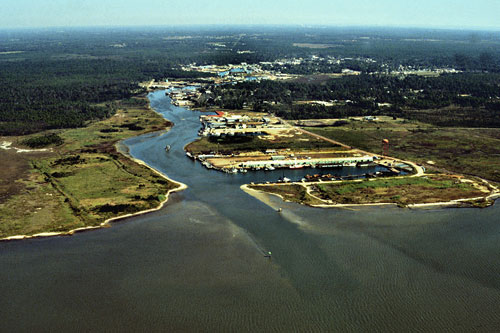
An aerial view of the Bayou La Batre harbor entrance from the Gulf of Mexico to the Northwest. U.S. Army Corps of Engineers.
Four months later, as the uncertainty simmered, Hurricane Katrina began crossing the Gulf, rising at its peak to a category 5, sending a massive storm swell toward the coast. On August 29, the water came ashore in Bayou La Batre, and there were suddenly new stories of terror and survival. Sophol Ngam and Chandara Ngam remembered the steady rise of the flood filling their house, and still it would not stop. They waded outside as the water kept coming and getting deeper, and they knew that soon they would have to swim. But they did not know how, and neither did most of their seven children. They began to call out, “No can swim! No can swim,” and finally Ralph Harbison, a neighbor and volunteer fireman, appeared with a boat and carried them to safety.[19]
Dozens of others had similar stories, reminiscent of earlier disasters, though there was a major difference between Hurricane Katrina and the storm of 1906. This time in the Bayou, nobody died. The damage, however, was nearly overwhelming, as people began returning to their homes or searching through the rubble of their seafood shops. As many as seven hundred houses were seriously damaged, along with many of the boats from the shrimping fleet and virtually all of the waterfront businesses. But then something remarkable happened. Over the next several months, money poured into Bayou La Batre, including $55 million from the federal government and several million more in private charity. Volunteers came from all over the country, and the community began to rebuild. Regina Benjamin, an African American doctor in the Bayou, revered by her patients, whose backgrounds cut across racial lines, was struck by a deepening sense of community: people—white, Asian, African American—pulling together to rebuild from the shared devastation.[20]
For the first few months, many of them lived in fema trailers, some in tents, but they were heartened by the promise of better times ahead. There was a $10 million grant from the Department of Housing and Urban Development (hud) to construct new housing north of town—105 affordable homes, with mortgage assistance for families in need. There were millions more in other federal funds for roads and other infrastructure, including a new waste treatment facility. There was also a $1.3 million grant from the Bush-Clinton Katrina Fund to rescue the twenty-three shrimp boats stranded on land. But perhaps as important as any of that money, believes the Bayou historian Hugh McClellan, a former ecologist with the U.S. Army Corps of Engineers, was the fact that Hurricane Katrina and its aftermath “gave the community a chance to refocus.” City officials brought in consultants from the Urban Land Institute, a thirty thousand–member nonprofit research organization. The consultants opposed the Tim James development plan, which was facing higher costs in the wake of Katrina.[21]
After a week-long visit a year after the storm, the eleven-member panel of consultants urged a more modest plan for development that would retain the traditional character of the village. The consultants saw the possibility of eco-cultural tourism—a refurbished waterfront, with pleasure boats moored beside the shrimping fleet, and tours of the nearby coastal savannah. As 2006 drew to a close, the Tim James plan appeared to be dead, and a series of community meetings seeking citizen input about the future had begun. As the Mobile Register reported in October 2006, “Hurricane Katrina has given Gulf Coast communities a moment to pause, take stock and rethink exactly what they want to be . . . Bayou La Batre can become one of those distinctive places that retain their identity while courting visitors, like Santa Fe, N.M. or Burlington, Vt.”[22]
Other people were more cautious, noting, for example, the casino developers on the Mississippi coast and their power to change the fundamental character of that place. But others were struck by the ironies of history. A hundred years after the storm of 1906, which had doomed the Bayou’s tourist economy, a similar disaster was raising hopes of its revival. The community needed something to revitalize the economy, and since the cultural and economic anchor of the Bayou was the sea, perhaps new visitors could be drawn without doing violence to its past. The mere possibility, said a local shipbuilder, is “music to our ears.”[23]
Preservation movements and economic pressures shaped the character of the French quarter. Follow thread in Souther, “French Quarter as Facade in a Divided City” >
I would like to thank Russ Henderson of the Mobile Register, Hugh McClellan and Arthur McRoy of the Bayou La Batre–Coden Historical Foundation, and Bayou artists Sheila Hagler and Peggy Denniston for their guidance.
[1] Alma Bryant, “It’s Time to Leave,” in The Bayou Anthology: A Compilation of Essays, Stories and Anecdotes, ed. Troy Vesper, Arthur McRoy, and Colleen Harrison (Bayou La Batre, 2006), 10.
[2] Cammie East Cowan, “1906: Mobile’s Hurricane History,” Mobile Register, Oct. 6, 2006, p. A4.
[3] Bryant, “It’s Time to Leave,” 5; Avery Bates interview by Frye Gaillard, Oct. 17, 2006, notes (in Frye Gaillard’s possession).
[4] Russ Henderson, “Old Gulf Coast vs. New Gulf Coast,” Mobile Register, Oct. 8, 2006, p. A4; U.S. Census Bureau: American FactFinder, http://factfinder.census.gov/home/saff/. Randy Schjott interview by Gaillard, Oct. 16, 2006, notes (in Gaillard’s possession).
[5] Russ Henderson, “Bayou Residents Lose Homes,” Mobile Register, Sept. 1, 2005, p. B5; Russ Henderson, “Boat Removal Begins,” ibid., July 15, 2006.
[6] Diane E. Silvia, “The Distinctive Character of a Bayou Community: Continuity and Change in Bayou La Batre from Prehistoric to Recent Times,” Gulf Coast Historical Review, 4 (Fall 1988), 49–63.
[7] Russ Henderson, “The Lessons of History in the Bayou,” Mobile Register, Nov. 10, 2005, p. A1; Arthur McRoy interview by Gaillard, Sept. 29, 2006, notes (in Gaillard’s possession).
[8] Hugh McClellan interview by Gaillard, Sept. 29, 2006, notes (in Gaillard’s possession); McRoy interview; Robert Shipp interview by Gaillard, Oct. 30, 2006, notes (in Gaillard’s possession).
[9] Russ Henderson, “The Herron Bay Way,” Mobile Register, Nov. 5, 2006, p. A4; Marie Schjott interview by Gaillard, Oct. 16, 2006, notes (in Gaillard’s possession).
[10] Randy Schjott interview.
[11]U.S. Census Bureau: American FactFinder, http://factfinder.census.gov/home/saff/.
[12] Businessman from Bayou La Batre interview by Gaillard, Oct. 5, 2006, notes (in Gaillard’s possession).
[13] Walton Kraver interview by Gaillard, Oct. 5, 2006, notes (in Gaillard’s possession); Harley Bates interview by Gaillard, Oct. 18, 2006, notes (in Gaillard’s possession); Rodney Lyons interview by Gaillard, Oct. 10, 2006, notes (in Gaillard’s possession).
[14] Heang Chhun interview by Gaillard, Nov. 1, 2006, notes (in Gaillard’s possession).
[15] Shipp interview; U.S. Census Bureau: American FactFinder, http://factfinder.census.gov/home/saff/.
[16] Bates interview.
[17] Shipp interview; Bates interview; McClellan interview; “Bayou La Batre: ‘Welcome to the Bayou,’” Bayou La Batre Chamber of Commerce, http://gulfinfo.com/bayoulabatre/.
[18] Henderson, “Old Gulf Coast vs. New Gulf Coast,” p. A4.
[19] Casandra Andrews, “Through Hell and High Water,” Mobile Register, Aug. 27, 2006, p. E1; Roy Hoffman, “‘We Thought It Could Have Been the End,’” ibid., Sept. 5, 2005, p. B1, B5. Chandara Ngam repeated that story and cited other, less dramatic acts of kindness by neighbors and coworkers, including an African American friend who, she said, “showed me the ropes” at a crab-picking shop where both of them worked. Chandara Ngam interview by Gaillard, Nov. 4, 2006, notes (in Gaillard’s possession).
[20] Russ Henderson, “Hurricane Katrina: One Year Later,” Mobile Register, Aug. 27, 2006, p. B1; Russ Henderson, “Katrina Bringing a Better Bayou?,” ibid., June 19, 2006, p. A1; Regina Benjamin interview by Gaillard, Oct. 20, 2006, notes (in Gaillard’s possession).
[21] Henderson, “Katrina Bringing a Better Bayou?,” p. A1; McClellan interview; Henderson, “Old Gulf Coast vs. New Gulf Coast,” p. A4.
[22] Henderson, “Old Gulf Coast vs. New Gulf Coast,” p. A4.
[23]Ibid.
